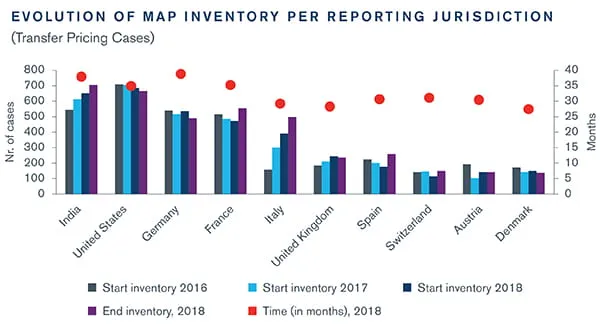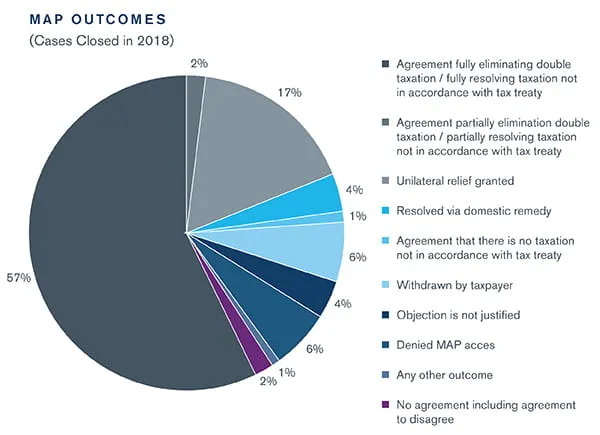The OECD has recently published its Mutual Agreement Procedure (MAP) Statistics for 2018. The MAP statistics summarize the MAP cases (transfer pricing and non-transfer pricing) that started or were closed in 2018, the average time to complete a case and the MAP outcome (i.e. whether the case has been resolved or not). In the first part of this article we provide a brief overview of the MAP statistics. The second part discusses potential strategies for a MAP application considering taxpayers’ preferences regarding timing, resources involved and desired outcome.
Overview of OECD’s MAP Statistics for 2018
The following chart summarizes the evolution of MAP transfer pricing cases from 2016-2018 and the average time to complete the cases (2018) for the ten countries with the largest inventory of MAP cases. The chart shows that the number of MAP cases remains high and has even increased significantly for India, France and Italy. Interestingly, there is a significant drop in number of cases for countries ranked fifth to tenth which may partially be a result of less companies resident in the respective countries. This finding suggests that there are certain countries with a higher likelihood that taxpayers will request a MAP.

The average time to complete a MAP is approximately 33 months—significantly higher than the 24 months suggested by the OECD. We expect the average time to close MAP cases to further increase because of the COVID-19 crisis and the uncertainty around how tax administrations may ultimately address the appropriate incorporation of the impacts of the crisis on arm’s length pricing for a given transaction, as well as because of tax office closure periods. In addition, the DAC 6 requirements to report cross-border arrangements could create more tax audits and therefore more MAP activity in the future.
While it may take some time to complete a MAP case, the data also shows that MAPs usually eliminate double taxation. The following chart shows that in the majority of cases, double taxation was eliminated. In only 2% of cases the parties did not agree to eliminate double taxation. The high number of resolved cases is also a result of arbitration clauses in Double Tax Treaties (such as between Germany and the U.S.) and in the EU Arbitration Convention which is binding for EU members. Such clauses provide a mechanism to force agreement, eliminating double taxation.

Strategies for MAP Applications (Transfer Pricing Cases)
The main objective of a MAP application is to resolve double taxation that arises from transfer pricing adjustments. In addition to that primary goal, taxpayers may also have certain preferences for the outcome of the MAP negotiation with regards to time to complete the case and the level of transfer pricing adjustment under the MAP resolution. Which of these secondary objectives is most important to the taxpayer influences the structure and level of detail of the MAP application? There are generally two broad categories: simple cases where taxpayers are seeking a quick resolution and are relatively indifferent about the level of transfer pricing adjustment, and more complex cases where taxpayers seek a desired outcome on the level of transfer pricing adjustment and/or to avoid many follow up questions from the tax authorities in the MAP process. The second category is a more expensive process for taxpayers. A combination of these desired outcomes is also possible. In the following we discuss potential options in more detail.
A potential option for taxpayers that do not want to spend a lot of time or resources on drafting the MAP application is to present their position and the position of the tax auditor. Such an approach could be achieved by simply using the transfer pricing documentation and the tax audit report. This option is recommended for relatively easy MAP cases with required arbitration and when the taxpayer’s only goal is to resolve double taxation (i.e. when the taxpayer is indifferent as to the level of transfer pricing adjustment so long as double tax is eliminated). Since in this case companies are confident that double taxation is resolved, they leave it up to the authorities to agree on a solution that is appropriate from their point of view. The advantage of this option is that it involves relatively little effort by the taxpayer and these cases can usually be closed more quickly as the fact pattern is relatively simple. An example of a rather simple case would be the adjustment of the sales margin of a local sales company, whereby the tax auditor generally acknowledges that the local company is routine in nature. In this instance, only the level of transfer pricing adjustment is negotiated in the MAP but not the functional profile of the sales entity.
For more complex cases, presenting the taxpayer's and tax authority’s positions in detail in the MAP application and summarizing the arguments exchanged during the tax audit is likely a better approach. Although this approach involves more effort in the application process, it may reduce the number of follow-up questions during the negotiation process.
If an agreement is envisaged and the taxpayer wants the case to be closed quickly, it may be useful to include an additional compromise proposal to the MAP application. The compromise proposal should discuss which tax authority arguments are generally acceptable and which are not (e.g. generally agree that some transfer pricing adjustments are appropriate but challenge the way the adjustments are calculated and present an alternative). Based on these discussions, the taxpayer may propose a compromise transfer pricing adjustment. The aim of the compromise proposal is to develop a position that both tax authorities can quickly agree on and that reduces the amount of transfer pricing adjustment. This procedure is recommended for MAPs with and without arbitration and could reduce the time to complete the case significantly.
In cases where the taxpayer does not accept the proposed adjustment or where the tax authority challenges key aspects of the transfer pricing model, it may be necessary to add a chapter that discusses further arguments against the tax authority's position. This option usually involves the most effort as arguments have to be presented and discussed in detail, and further arguments might need to be developed. The aim of this approach is to provide the foreign competent authority with as many arguments as possible to put them in a good negotiating position. Thus, this option is recommended if the taxpayer wants to avoid transfer pricing adjustments and is willing to spend more time and resources on the MAP, e.g. situations where there is a negative impact on the effective tax rate or when the taxpayer wants to avoid a precedent case impacting future periods. However, this approach carries the risk that authorities will need more time to complete the case (e.g. if it is resolved in arbitration). In addition, there is a risk that authorities will not reach an agreement (if no arbitration clause exists) or negotiate a compromise that may not be in the interest of the taxpayer.
Summary
The alternative forms of MAP applications discussed above provide an overview of possible strategies for efficient MAP procedures. The choice of strategy depends largely on the individual case and the taxpayer's preferences regarding timing, resources involved and desired outcome of the MAP. As such, taxpayers should weigh these factors and decide on the best strategy before preparing the application.


